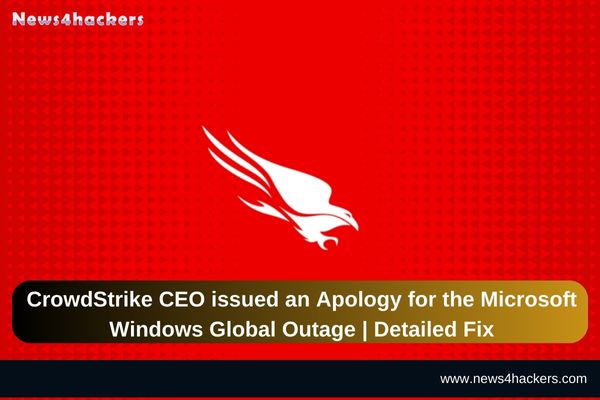CrowdStrike CEO issued an Apology for the Microsoft Windows Global Outage | Detailed Fix

CrowdStrike CEO issued an Apology for the Microsoft Windows Global Outage | Detailed Fix
Efforts to reduce a new Windows threat resulted in the shutdown of systems that were running CrowdStrike’s Falcon sensor.
The CEO of CrowdStrike has issued an apology to the company’s consumers and partners for the failure of their Windows systems. Additionally, the company has disclosed the error that culminated in the unfortunate incident.
“I want to sincerely apologize directly to all of you for today’s outage. All of CrowdStrike understands the gravity and impact of the situation,” CrowdStrike founder and CEO George Kurtz wrote in a blog post titled “Our Statement on Today’s Outage.”
He reiterated the organization’s previous assertion that the incident, which caused the Blue Screen of Death (BSOD) on computers worldwide on Friday, July 19, was not the consequence of a cyberattack.
Learn more about the Microsoft Windows Global Outage.
However, he employed rhetorical devices to imply that the Falcon security platform of the company was not at fault and that the incident was an accident.
What was the Cause of the CrowdStrike Crash?
Kurtz stated that the outage was the result of a defect detected in a Falcon content update for Windows hosts as if the defect were a naturally occurring phenomenon that his staff had discovered.
The company announced in a separate blog post on Saturday that the Falcon sensor’s defective content update was distributed to Windows machines at 04:09 UTC (0:09 Eastern Time) on Friday. A remedy was deployed 79 minutes later. The blog post provided technical details of the incident.
It was, of course, too late by that time: A significant number of the systems that had received the update were already inactive.
“Systems that run Falcon sensor for Windows 7.11 and above and downloaded the updated configuration between 04:09 UTC and 05:27 UTC were at risk of a system crash,” the blog post stated.
In certain instances, the Blue Screen of Death was displayed on numerous Windows systems, which led to missed flights, closed call centers, and canceled surgeries because of the crashes of systems operating the Falcon sensor.
Nevertheless, Kurtz maintained in his correspondence with consumers that the Falcon sensor would not affect any protection.
That may be accurate for systems that did not receive the flawed content update, and in a strict sense, a system that is no longer operational does not require protection. However, customers who were impacted will be questioning whether CrowdStrike genuinely safeguarded their systems during those critical 79 minutes.
What was the content update that CrowdStrike released that was defective?
Multiple times per day, CrowdStrike modifies the configuration files for the endpoint sensors that are integrated into its Falcon platform. It refers to those updates as “Channel Files.”
The company stated in its technical blog post on Saturday that the defect was located in a channel it refers to as Channel 291. The file is located in the directory “C:\Windows\System32\drivers\CrowdStrike\” and has a filename that begins with “C-00000291-” and ends with “.sys”. Despite the file’s name and location, CrowdStrike maintained that it is not a Windows kernel driver.
Channel File 291 is employed to transmit Falcon sensor information regarding the evaluation of “named pipe” execution. These pipelines are utilized by Windows systems for intersystem or interprocess communication, and they are not inherently harmful; however, they may be abused.
Also Read : Microsoft Windows Global Outage | Users Share this “Error Message” Screenshot | Worldwide Blunder
“The technical blog post elucidated that the update that took place at 04:09 UTC was intended to target newly observed, malicious named pipes that are utilized by common C2 [command and control] frameworks in cyberattacks.”
Nevertheless, it stated, “The operating system crashed as a result of a logic error that was triggered by the configuration update.”
A rapid resolution, but a recovery that is delayed
Removing the defective content from the file was sufficient to prevent the issue from reoccurring. “The content in Channel File 291 has been updated by CrowdStrike to rectify the logic error.”
However, this did not resolve the issue for the numerous Windows machines that had previously downloaded the defective content and subsequently terminated.
For those customers, CrowdStrike published an additional blog post that included a significantly more extensive list of actions that affected customers could take. The post included recommendations for remotely identifying and automatically restoring affected systems, as well as comprehensive directions for temporary solutions for impacted physical machines or virtual servers.
The technical blog post concluded that systems that are not presently affected will continue to operate as expected, offer safeguarding, and have no risk of experiencing this event in the future.
About The Author:
Yogesh Naager is a content marketer who specializes in the cybersecurity and B2B space. Besides writing for the News4Hackers blogs, he also writes for brands including Craw Security, Bytecode Security, and NASSCOM.











